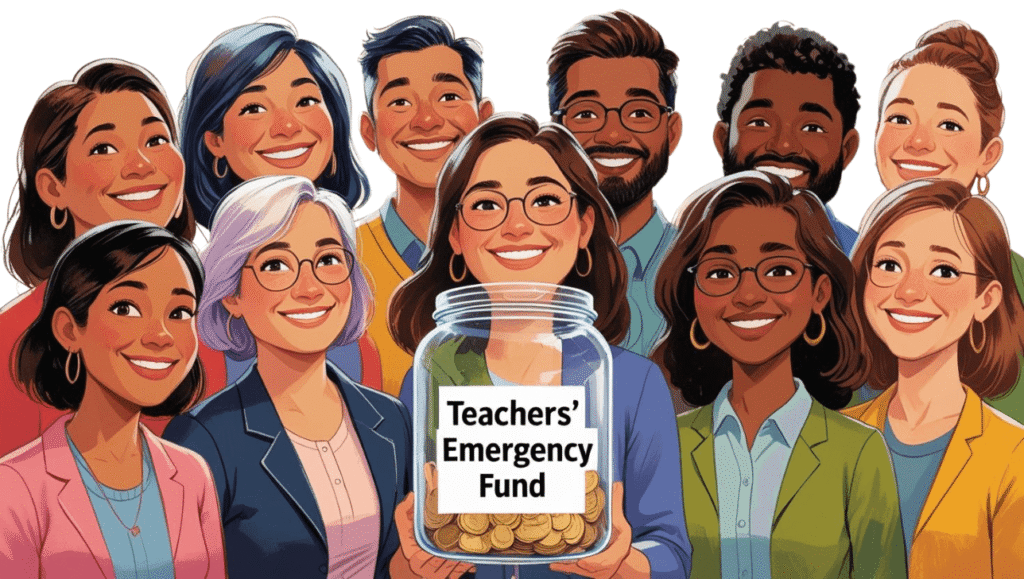Table of Contents
ToggleWhere to Invest Money in India 2025: Smart Ways to Beat Inflation

This story shares general money lessons for teachers and families, not personalized financial advice
I came home after school, calm and relaxed, with a hot cup of chai in hand. Since 2009, I’ve built a routine of reading Mutual Fund Insight, Outlook Money, and other guides to stay sharp about money.
Back in 1995, during college, managing rent, food, and Notebooks with just ₹500 a month was possible. Today, that same ₹500 barely covers a single lunch. Times have changed—expenses keep rising, and saving alone is no longer enough.
Just then, Dhruv asked me, “Papa, you’ve been reading about money for years… but tell me, where to invest money in India?”
That simple question captures what every teacher and family is thinking in 2025. And the answer lies not in traditional savings, but in inflation-beating, wealth-creating investments like Mutual funds that can secure the future. If you’re curious about options that balance both safety and good returns, I’ve explained them in detail here: Safe Investments in India with High Returns.
Why Beating Inflation Matters
The biggest enemy of our money isn’t poor spending—it’s inflation. It silently eats away at the value of money year after year. For teachers and middle-class families, this has a clear message: if your savings don’t grow faster than inflation, you’re actually losing purchasing power.
Think of it this way: earning 4% returns when inflation is 5.5% means your money is shrinking in real terms. Fixed deposits and savings accounts may feel “safe,” but with interest rates around 5–6% (and even lower after tax), they hardly keep up. In reality, keeping all your money in such accounts can feel like “safely losing money.”
That’s why the real question is not just about saving—but about investing in options that consistently beat inflation and create long-term wealth.
Over the last decade (2015–2025), equities and gold delivered double-digit annual returns far above inflation (red dashed line ~4.7%), whereas traditional safe assets like bonds, deposits, or real estate barely kept ahead. Data shows mid-cap equity mutual funds averaged ~16.1% yearly returns, gold ~13.9%, and even large-cap equity funds ~11.8%, all comfortably beating consumer inflation (~4.7%). By contrast, 10-year government bonds returned only ~6.9%, and residential real estate about 5.2% annually, only marginally outpacing inflation. The lesson is clear: to truly grow wealth, one must include investments that yield more than the inflation rate.
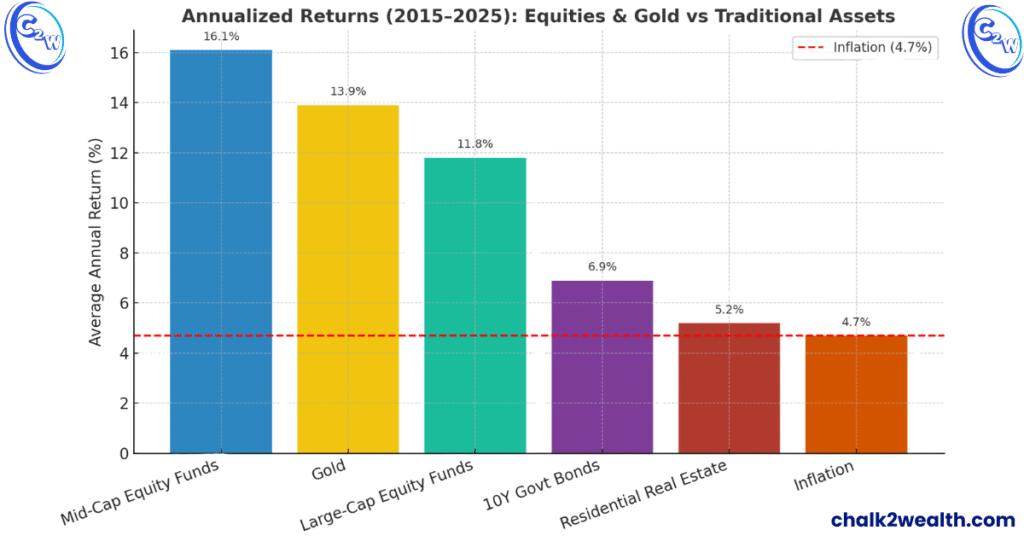
“Inflation and return figures are based on historical averages (2015–2025) and may vary; past performance is not a guarantee of future results.”
Where to Invest Money in India in 2025
Now comes the real question every teacher and family is asking: where to invest money in India so that it truly grows and beats inflation? Let’s break down the best inflation-beating, wealth-creating options available today.
Before chasing high returns, every teacher or family should build a foundation of safety. India’s government-backed schemes protect your principal and still offer returns slightly above inflation. They won’t make you rich overnight, but they ensure stability.
- PPF – 7.1% tax-free, 15-year lock-in; great for retirement.
- EPF/GPF – ~8% (EPF 8.15% for FY2023–24); safe and steady for salaried teachers.
- NSC – 7.7% with 5-year lock-in, plus 80C tax benefits.
- SSY – 8.2% (for girl child), tax-free and sovereign guaranteed.
- SCSS – 8.2% quarterly payouts, perfect for retired teachers.
- RBI Floating Rate Bonds – ~8.05%, 7-year tenure, zero credit risk.
- Other options – Post Office deposits, KVP (~7.5%), and bank FDs (~6–7%).
These schemes are excellent for capital protection and modest real growth. But to truly create wealth, you’ll need to combine them with higher-return assets like mutual funds, REITs, gold, or NPS.
For a full breakdown of rates, lock-in, tax treatment, and safety features, check my detailed guide here:
Safe Investments in India with High Returns – 2025
Equity Mutual Funds (SIP) – Harness Stock Market Growth
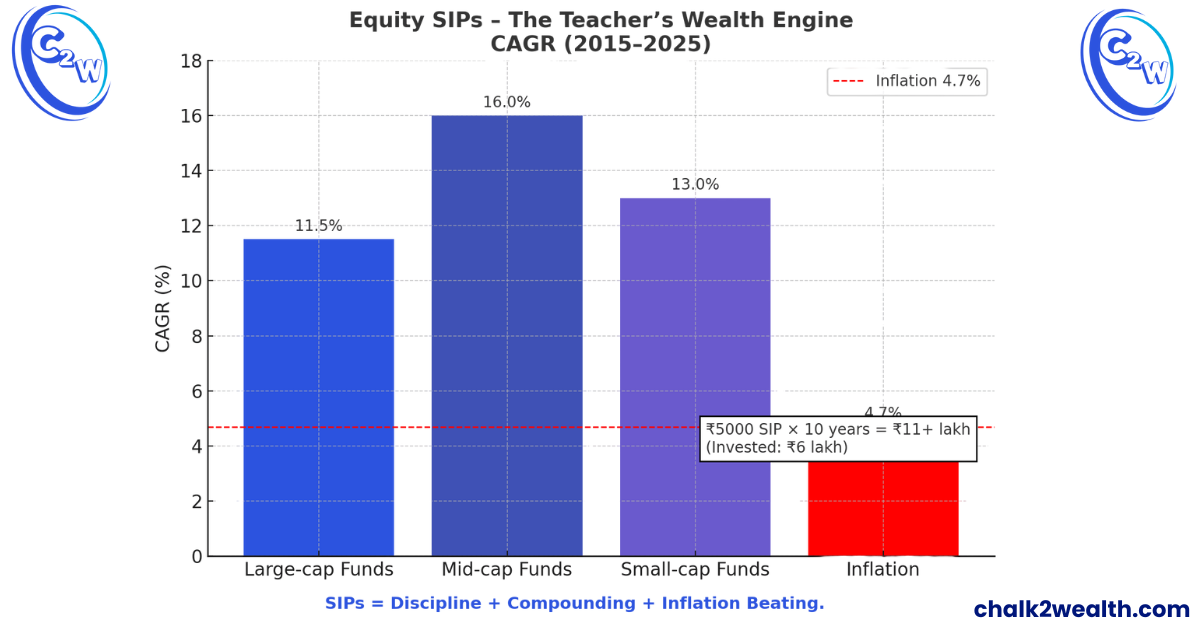
“Returns shown (2015–2025) are based on historical averages; future performance may differ. This is for educational purposes only and not investment advice.”
If beating inflation is the goal, equities are the proven champions. Historically, the stock market has delivered returns well above inflation over every long period. For anyone wondering where to invest money in India to grow wealth steadily, equity mutual funds are the simplest way for teachers and families to benefit from this growth without needing to pick stocks themselves.
What kind of returns? Over the last 10 years, Indian equity mutual funds have delivered double-digit annual returns. Large-cap equity funds (investing in blue-chip Nifty/Sensex companies) gave around 11–12% CAGR. Mid-cap funds did even better at ~16% CAGR, and small-cap funds around 13%. For context, inflation averaged ~4.7% in this period. This means equity funds beat inflation by a huge margin, effectively tripling or quadrupling the real value of money over a decade. Even over shorter horizons, despite ups and downs, most equity funds’ 5-year and 10-year returns have consistently stayed above 10% per annum, outpacing inflation comfortably. That’s why for middle-class families asking where to invest money in India to beat rising prices, equity funds deserve serious attention.
Systematic Investment Plans (SIPs) are an ideal way to invest in mutual funds for beginners. With an SIP, you invest a fixed amount (say ₹1000 or ₹5000) every month, which instills discipline and helps you average out market volatility. Some months you’ll buy at higher market levels, some at lower levels – over time this evens out your purchase cost. This is perfect for teachers investing from monthly salary. The power of compounding and rupee-cost averaging can be astonishing. For example, an SIP of ₹5,000/month in a Nifty 50 index fund for the last 10 years would have grown to roughly ₹11+ lakh today (while you invested only ₹6 lakh total). That’s the magic of ~12-15% compounded returns working for you.
Of course, equity mutual funds are not “guaranteed” – their value fluctuates with the stock market. There will be years when your fund is down. But if you stay invested over the long term (10+ years), the short-term risks get smoothed out by long-term growth. The long-term trajectory of the market follows India’s economic growth, which is why stock investments have outpaced inflation in almost every 10-year period. The key is to start early and stay invested. Even a modest allocation to equity can greatly boost your overall portfolio return – a crucial insight for anyone deciding where to invest money in India for long-term goals.
How to choose funds? As a conservative investor (like a cautious teacher), you don’t need to dive into niche or sector funds. Diversified equity funds or index funds that invest across large companies are a good start. For example, an Index fund tracking the Nifty/Sensex or a large-cap fund gives broad market exposure. If you want slightly higher growth and can tolerate more swings, a mid-cap fund or flexi-cap fund (which invests across sizes) can be added – these have given higher returns historically, though with more ups and downs. The mantra is to align with your risk comfort: stick mostly to large-cap or balanced funds if you’re wary, and only add small/mid-cap funds once you understand volatility.
Teacher’s tip: Don’t be swayed by the myth that “mutual funds are too risky” for you. It’s true that equity funds can be volatile in the short run, but not all mutual funds are high risk. There are even conservative hybrid funds (more on them later) that mix some bonds with stocks to reduce volatility. And remember, not investing in equities at all can be risky to your long-term goals – you risk your savings not growing enough to fund future costs. As the popular saying goes, “Mutual Funds Sahi Hai” – mutual funds are indeed a good choice – but choose ones that match your risk profile. Over the long run, a well-chosen equity mutual fund portfolio is one of your best answers to where to invest money in India to build wealth.
Balanced/Hybrid Funds – Mix of Safety and Growth
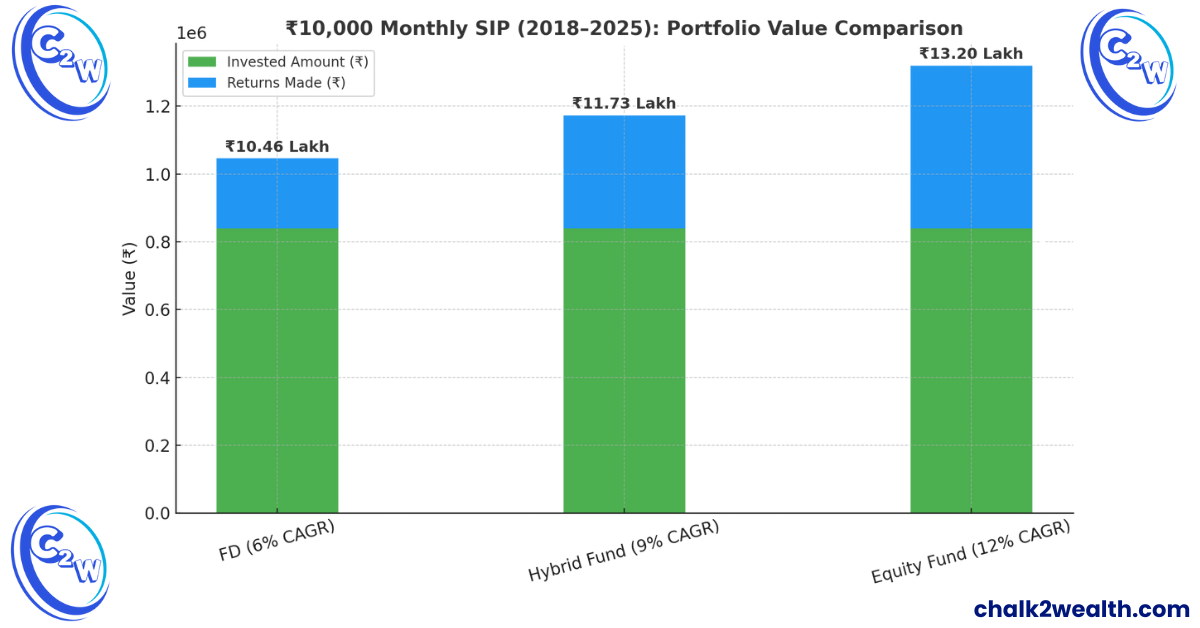
“Figures are illustrative based on assumed CAGR (2018–2025); actual returns may differ. This chart is for educational purposes only and not investment advice.”
For those who find pure equity funds a bit too volatile, balanced or hybrid mutual funds offer a middle path when deciding where to invest money in India. These funds combine equity (stocks) and debt (bonds) in one portfolio. A typical Balanced Hybrid Fund may keep ~50–70% in equities and the rest in bonds. Sub-types exist too: Aggressive Hybrid Funds (equity-oriented) invest ~75% in stocks, while Conservative Hybrids hold just 10–25% in stocks and the majority in safer debt instruments.
The idea is simple: equity drives growth, debt provides stability. Over a full market cycle, a good hybrid fund can deliver ~8–10% annual returns. That’s lower than pure equity funds in bull markets, but far better than FDs — and with a smoother ride during downturns. In fact, many Indian hybrid funds have delivered ~9–10% CAGR over the past decade, with some “aggressive” hybrids doing even better. For teachers wondering where to invest money in India for inflation-beating returns without excessive risk, hybrids often strike the right balance.
Consider what happens in a crash: if the stock index falls 10%, a hybrid fund with debt cushioning may only fall 5%. When markets rise, the equity portion ensures participation (though not as much as a 100% stock fund). That’s why starting an SIP in a balanced fund is like training wheels for equity investing — it helps teachers and middle-class families get growth above inflation, but with less volatility.
Who should consider hybrid funds?
- Teachers and professionals who still feel nervous about stocks.
- Mid-career savers who want better returns than fixed deposits.
- Investors nearing retirement who want safety with growth.
- Younger investors using hybrids as a stepping stone before moving to higher equity allocations.
A newer variant is Balanced Advantage Funds (BAF). These dynamically shift equity exposure depending on market conditions — aiming to “buy low, sell high” automatically. They have gained popularity in India because they usually control volatility while targeting ~8–10% returns.
Real Story from a Teacher’s Life
Mr. Rajan, a 45-year-old teacher from Himachal, was unsure about where to invest money in India. Fixed deposits felt safe but disappointing. In 2018, he began a ₹5,000 SIP in a hybrid fund. During the 2020 crash, his fund fell, but only half as much as pure equity funds. Encouraged, he stayed invested. By 2025, his investment delivered ~10% annualized returns — far better than his old FDs. Today, Rajan is more confident and ready to increase equity exposure.
Lesson: Hybrid funds can give teachers the confidence to invest, beat inflation, and grow wealth — without sleepless nights.
Real Estate & REITs – A Modern Way to Own Property Without Crores
Real estate has always been seen as a classic hedge against inflation – rents and property values tend to rise as the economy and prices grow. But for most middle-class families and teachers, buying physical property requires huge capital, heavy loans, and it comes with illiquidity and maintenance headaches. So, when we ask where to invest money in India for real estate exposure without the stress of ownership, the answer increasingly points towards REITs – Real Estate Investment Trusts.
A REIT works like a mutual fund for real estate: it owns a portfolio of income-generating properties (office parks, malls, commercial complexes) and distributes most of the rental income to investors as dividends. Instead of buying a flat, you can buy units of a REIT directly on the stock exchange, just like shares.
Why Consider REITs?
- Regular income + growth: Indian REITs currently offer rental yields of ~6%–7.5% per year, which is better than many fixed-income options and far higher than house rental yields (often just 2–3%).
- Inflation protection: As rents increase and property values rise over time, REIT payouts and asset values also grow, helping investors stay ahead of inflation.
- Accessibility: You can start with as little as ₹10,000, making REITs one of the most approachable answers to where to invest money in India if you want real estate exposure.
For example, Embassy Office Parks REIT (India’s first REIT) listed in 2019. In its early years, it delivered ~25% total returns (dividends + price appreciation). Today, its dividend yield alone is in the high single digits. Imagine owning a fraction of Grade-A office parks in Bengaluru, with companies like Google and JP Morgan paying rent — that’s the power of REITs.
Risks & Reality Check
- Market-linked: REIT prices can move with stock market sentiment and interest rate changes.
- Volatility: Less volatile than stocks, but not risk-free.
- Long-term edge: In inflationary times, property values and rents usually rise, so REITs tend to hold their ground better than many other assets.
Who Should Invest?
- Teachers and professionals who want real estate exposure but don’t have crores to invest.
- Investors seeking semi-passive income from rent-like dividends.
- Anyone looking to diversify their portfolio beyond stocks and bonds.
For a teacher, even allocating 5–10% of the portfolio to REITs can be smart diversification. It’s like enjoying the steady rent of a landlord — but without worrying about tenants, repairs, or legal paperwork. In the bigger picture of where to invest money in India in 2025, REITs are emerging as a practical, inflation-beating tool.
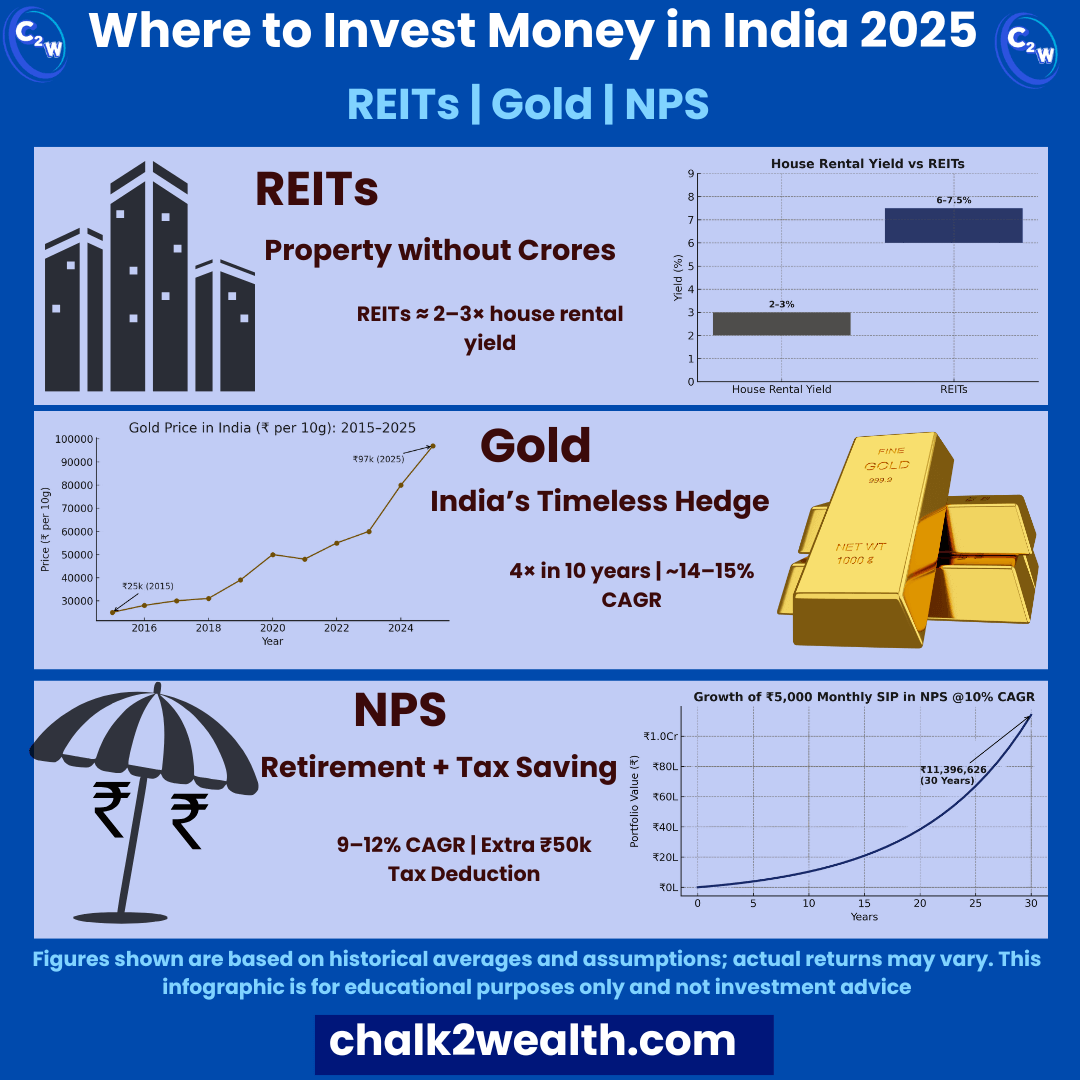
Gold – Inflation’s Old Foe, India’s Trusted Friend
Gold holds a special place in Indian households. Beyond cultural affection, gold has consistently proven itself as a solid long-term store of value. When inflation surges or when economies falter, gold often shines. Why? Because gold’s price usually rises when paper currency loses value. That’s why, when families wonder where to invest money in India to protect wealth during uncertain times, gold remains a timeless answer.
Historical Performance
Over the last decade, gold in India has delivered outstanding returns, often outpacing inflation. Its price rose from about ₹25,000 per 10g in 2015 to nearly ₹97,000 per 10g in 2025 — that’s ~4X in 10 years, translating to ~14–15% CAGR.
- 2019: Gold surged ~25%
- 2020: Another ~28% gain during the pandemic
- 2021: A small -4% dip, but gains soon resumed
The message is clear: despite short-term pauses, gold’s long-term trend has been wealth-creating, especially in crisis years when inflation or uncertainty hit hard.
Why Gold Matters in a Teacher’s Portfolio
- Low correlation with stocks: Gold tends to rise when equity markets fall.
- Inflation hedge: As rupee weakens, gold becomes costlier, preserving purchasing power.
- Crisis protector: During 2020’s pandemic shock and the 2022 inflation spike, gold shielded wealth while stocks stumbled.
Financial planners usually recommend 5–15% allocation to gold. For teachers seeking safe yet effective options on where to invest money in India, gold adds stability and acts like “insurance” within the portfolio.
Things to Keep in Mind
- No cash flow: Gold doesn’t pay dividends or interest (except Sovereign Gold Bonds, which offer 2.5% yearly interest).
- Patience needed: In booming stock-market years, gold can stagnate. But its true strength appears in tough times.
Still, the numbers speak: ₹1 lakh in gold a decade ago is worth ₹3–4 lakh today. Not bad for an asset often dismissed as “just safe.” For Indian teachers and families, gold is more than tradition — it’s a practical tool for long-term wealth preservation.
(Fun fact: In 1990, gold was ~₹3200 per 10g. Today ~₹97,000. That’s an 30x increase in 35 years, averaging ~9% yearly. It beat inflation and also many stock portfolios in that long span!)
National Pension System (NPS) – Balanced Retirement Fund with Tax Benefits
The National Pension System (NPS) is a government-sponsored retirement investment option that has been gaining popularity. While its primary goal is to build a pension corpus, from an investment perspective NPS is essentially a diversified mutual fund with very low cost – it invests your money into a mix of equities, corporate bonds, and government bonds as per your chosen allocation. For someone looking to beat inflation for long-term goals (like retirement), NPS is a great vehicle, often delivering returns on par with pure equity funds, but with an element of safety due to debt portion.
Return profile: NPS returns are market-linked (not guaranteed), but the track record is impressive. According to analysis by experts, NPS has delivered between 9% to 12% CAGR over the long term, which is comparable to the returns of large-cap equity mutual funds and much better than traditional provident funds (GPF/EPF ~8% or PPF 7.1%). In fact, data from PFRDA (pension authority) shows the active equity funds in NPS have yielded ~10-14% annualized over 10 years (the exact figure depends on the fund manager; some like HDFC or UTI pension fund’s equity plan have been on the higher end ~13-14%). Even the pure bond side of NPS (government bond plan) delivered around 9% over 10 years, thanks to active management and compounding of interest.
So NPS has indeed beaten inflation by a wide margin historically. And it does so with a balanced approach – you can allocate up to 75% in equity (if you choose Active mode and you’re younger than 50) and the rest in safer bonds. Or you can let the Auto-choice gradually adjust your mix (more equity when young, more bonds as you age). This makes NPS a relatively hands-off way to invest for long term with both growth and safety. Many refer to NPS as “the one investment that gives the best of PF (safety) and mutual fund (returns)”.
Tax benefits: NPS offers an exclusive tax deduction of ₹50,000 under Section 80CCD(1B) beyond the usual ₹1.5 lakh 80C limit. This is a big incentive for middle-class earners to invest in NPS. For a teacher in the 20% tax bracket, investing ₹50k in NPS saves ₹10k tax straight away. Effectively, that ₹50k investment costs you only ₹40k out of pocket. Over years, these tax-saved portions also compound. Additionally, your own contribution (within ₹1.5L limit) and any employer contribution (for private sector folks) also have tax benefits. At withdrawal, 60% of the corpus can be taken tax-free, and the remaining 40% is used to buy an annuity (pension) which is taxable as per slab.
Lock-in and liquidity: NPS Tier I (the primary account) is essentially locked until age 60 (with some allowances for partial withdrawal for specific needs like home purchase, illness, education). This is good in a way – it forces you to save for retirement. Tier II is optional and works like an open mutual fund (you can withdraw anytime, but no tax benefit). The lock-in means you should be confident you won’t need this money before 60. Think of NPS as your “don’t touch till retirement” pot that will later provide a monthly pension.
For young teachers especially, joining NPS early can result in a massive corpus due to compounding. Even a modest ₹3000/month contribution could grow to crores over 30 years if the scheme continues to deliver ~10% returns. It’s a very efficient way to beat inflation for your retirement goal, as the money remains invested across high-growth assets and you rebalance regularly via contributions and life-stage allocation.
One consideration: at retirement, 40% of NPS must be converted to an annuity (which gives you a guaranteed monthly pension but at rates prevailing then, which currently might be ~6% returns). 60% you can take out as lump sum (tax-free). So effectively, a portion of your corpus in the end will yield fixed returns. Even so, overall NPS gives you a far superior outcome than just piling money in, say, GPF/EPF alone.
In summary, NPS is smart investing on autopilot. It invests in equity for growth and debt for stability, it has ultra-low charges, and the government incentivizes it with tax breaks. If beating inflation for the long run is your aim (and it should be, for something like retirement which could see 30+ years of inflation), NPS deserves a spot in your plan. Many teachers who are already contributing to GPF/EPF use NPS to supplement their retirement savings and take advantage of the extra ₹50k tax deduction. Given the returns so far, one can see why – NPS has more than held its own against other investments.
Other Noteworthy Options
We’ve covered the major categories, but whenever the topic of where to invest money in India comes up, a few other options (and doubts) usually enter the conversation:
1. Direct Stocks
Some experienced investors — maybe that commerce teacher in your staffroom who’s also a stock market enthusiast — prefer buying shares directly. There’s no doubt a well-chosen stock can beat inflation many times over. Think of someone who bought Infosys or Asian Paints in the early 2000s and simply held on.
But here’s the truth: picking individual stocks requires time, research, and the temperament to ride out volatility. For most teachers and families, diversified mutual funds or ETFs are a simpler, safer route to equity investing. If you truly have a passion for research and understand businesses, you may allocate a small portion to direct stocks. Otherwise, let professional fund managers or index funds do the heavy lifting for you.
2. ULIPs and Traditional Insurance Plans
These are often pitched as “safe” investment options with insurance bundled in. But you should be very cautious. Mixing insurance and investment usually leads to disappointment:
- Endowment insurance plans: Long-term returns often hover at just ~5–6%, barely keeping pace with inflation (sometimes less after fees). Liquidity is poor, and you’re locked in.
- ULIPs (Unit Linked Insurance Plans): These do invest in markets, but high charges in the initial years often drag down performance compared to mutual funds.
If your goal is wealth creation, it’s wiser to:
- Take a pure term life insurance policy (to protect your family).
- Invest separately in high-return avenues like mutual funds, PPF, or REITs.
As a mantra: Insurance is not an investment – it’s protection. Treat it that way, and let your real investments do the compounding.
3. Cryptocurrency and New-Age Assets
By 2025, younger teachers and even students sometimes ask: “What about crypto, NFTs, or derivatives — can they make us rich?”
The reality: cryptocurrencies are highly volatile and speculative. Some made fortunes, but many lost heavily. Unlike equity, debt, or real estate, crypto doesn’t have intrinsic backing. If you’re tech-savvy and curious, you could experiment with a tiny sum you’re prepared to lose — only after building a secure foundation with proven assets.
For most teachers and families, crypto isn’t necessary for beating inflation. It’s closer to a high-stakes gamble than a reliable investment. Commodity trading or derivatives fall in the same bucket — they’re better labeled speculation, not true investing.
The Bigger Question: How to Combine These?
At this stage, we’ve seen multiple answers to where to invest money in India — equity funds, hybrids, gold, REITs, PPF, bonds, and more. But knowing the menu isn’t enough. The real challenge (and art) lies in combining them wisely based on your life stage and risk appetite.
A young teacher just starting out will need a very different portfolio mix than someone five years from retirement. That’s what we’ll look at next: practical allocation strategies to turn these options into a balanced wealth-creation plan.
Final Thoughts
For most Indian teachers and middle-class families, the priority has always been the safety of money – and rightly so, since it’s hard-earned. But as we navigate 2025 and beyond, we must update our strategies. The good news is that you don’t have to sacrifice growth for safety. With informed choices, you can have both: a portfolio that lets you sleep peacefully knowing your capital is secure, and one that wakes up growing robustly each year!
In 2025, options abound that were not as accessible a few decades ago: we have government-backed schemes offering 7–8%+ interest, and market-based instruments like mutual funds, REITs, NPS that have demonstrated the ability to deliver 10%+ over the long run. By leveraging a mix of these, you can ensure your savings not only stay safe but also beat inflation and build wealth.
When Dhruv asked me “Where to invest money in India?”, I realized that the answer isn’t one single thing – it’s a recipe: a foundation of safe investments plus a healthy dose of growth investments. I explained to him (and to my colleague Mr. Shiv Kumar in the staffroom the next day) that simply saving in traditional ways won’t secure the future. Inflation is like a stealthy termite that can hollow out even a solid-looking log of savings. To protect ourselves, we must invest in instruments that outgrow the inflation termite’s bite.
The encouraging reality is, as we’ve detailed, safe investments with relatively high returns do exist, and higher-return investments can be made safer through knowledge and proper planning. The real challenge is overcoming old fears and habits. Once we do, we find that “safe” no longer means settling for sub-par growth. Even a cautious teacher can, with the right mix, target returns of 8–10% or more and achieve their life goals without undue risk.
So, here’s to smart investing – chalking out the path to wealth, one informed step at a time. In the words of Chalk2Wealth’s mantra: “Safety does not mean sacrificing growth. A teacher’s best investment is one that protects hard-earned savings and beats inflation.”
FAQs on Where to Invest Money in India
Q1: Which investment is best for high returns?
For long-term high returns, equity mutual funds via SIPs are best.
- Large-cap funds: 11–12% CAGR (stable).
- Mid-cap funds: 14–16% CAGR (higher but riskier).
Teacher takeaway: FD/PPF protect capital, but SIPs grow wealth faster and beat inflation.
Q2: Which investment is best for high returns in India (2025)?
Top options in 2025:
- Equity mutual funds (SIP) → 12–16% CAGR.
- Gold (SGBs) → 14% CAGR in last decade + 2.5% interest.
- REITs → 6–7% yield + growth.
- NPS equity plan → 10–12% CAGR + tax savings.
Teacher takeaway: Combine equity + gold + NPS for high returns and inflation protection.
Q3: Which investment gives the highest return in India 2025?
Historically, the highest returns come from equity-related investments:
- Mid-cap equity mutual funds: ~14–16% CAGR (10 years).
- Small-cap funds: ~13–15% CAGR (high risk, high reward).
- Direct stocks (like Infosys, Asian Paints, HDFC): 15–20%+ CAGR for long-term holders.
- Gold also delivered ~14% CAGR (2015–2025), especially in uncertain times.
- Crypto & new-age assets gave extreme highs but are too risky for most teachers.
Teacher Takeaway:
For long-term wealth creation, equity mutual funds via SIPs are the most practical highest-return option for middle-class families — safer than direct stock picking, and historically beating inflation by 2–3x.
About the Author:
Jagan Charak is the Headmaster of a government school in Himachal Pradesh and the founder of Chalk2Wealth, a teacher-first financial literacy platform. He writes to help teachers and families understand money, avoid common traps like EMIs, credit card debt, and mis-sold insurance, and build long-term financial security. Being an educator himself, he firmly believes that financial education is as critical as academic education for a secure future.
This content is written for educational and informational purposes only. It is not financial advice. Please consult a qualified financial advisor before making investment decisions.
If this article helped you, share it with one fellow teacher today. Together, we can build financial literacy in our staffrooms. And before you leave—drop a comment below: which investment option do you trust the most in 2025? Your experience can guide other teachers too


